


This essay includes soft sounds and whispers.
Headphones are recommended.
Before ASMR videos, there were oceans. When taped, the ocean becomes a haze of waves breaking and distorting. When uploaded to YouTube, the ocean becomes search optimised. There are now oceans of digital oceans.
Before ASMR videos, there was Bob Ross on The Joy of Painting (1983-94). Instead of rolling and tussling waves, we see and hear Ross collect little rolls of paint on his palette knife. Ross softly shares oil painting tips, like making sounds to get the shapes of waves right. He impersonates waves crashing: schoo, tchwoong! His paint brushes make gentle scratchy sounds as they sweep across the canvas. I am haunted by a desire to be one of Ross’s canvases.
[1]
Sometimes I feel like footnotes are secrets that the author whispers to the reader.
Before ASMR videos, there were also guided meditations, relaxation tapes, Lita’s Massage Clips, and Maureen Garth books. There were Avon ladies and ladies who love curtains [1]. There was my primary school ‘computer time’ teacher, a delicate woman in her 70s with a pyramid of grey hair, who always spoke in a low parched whisper. She conducted her classes with the lights switched off and the air conditioning turned up high. Her cold cavern was lined with Windows ’95 computers. The blue light emanating from the bulging screens glowed like stained glass windows. I have vivid memories of this teacher instructing us to ‘double click the little mouse button,’ her cadence clattering pleasurably over her words with a strange reverence, as if we were preparing to complete a technopagan ritual together.
[2] Before their formalisation, ASMR videos were often referred to as ‘whisper videos’ due to the prevalence of whispered commentary. Reflecting this tendency, many early ASMR channels bore usernames containing references to whispering: WhisperingLife, WhisperSister, AuroraWhispers, TheWhisperWinds, GentleWhispering etc.
[3]
ASMR content has also begun to appear on TikTok and Twitch.
ASMR videos are their own kind of post-internet ritual. Like relaxation tapes, ASMR videos are named after the feeling they are meant to produce: Autonomous Sensory Meridian Response, a term coined by Jennifer Allen only in 2010 to describe a relaxing tingling sensation. The videos tend to show a person performing quiet sounds and slow movements for a camera. The specific sounds and movements vary, but many are accompanied by canorous words whispered into sensitive binaural microphones [2]. A diverse range of key terms categorise ASMR videos into searchable genres: soft spoken, whispered, keyboard sounds, massage, tapping, gaming, mukbang, inaudible whispers, cranial nerve exam, haircut, layered sounds, trigger compilation, unintentional ASMR, role play, personal attention. Videos that are over an hour in length are common and many have been watched millions of times on YouTube, or an ASMR-aligned app, like Calm or Tingles [3]. ASMR content is watched to various ends: to produce the feeling of ASMR proper, as background noise, to decrease anxiety, or hasten sleep. ASMRtists – a common, clunky portmanteau for producers of ASMR content (that I use reluctantly) – often complete their activities slowly and inefficiently. In the small subgenre of lid sound videos, for instance, jars are opened and closed in the most ineffective ways possible: the lids are twisted off and on slowly, repeatedly, with extended periods of the ASMRtist jangling the lid over the lipped opening of the jar, intentionally missing the tracks of the opening to elongate the lid’s journey downward. The performer takes their time to find the gentle musicality of the container and the best articulations for producing relaxing tones.
It is also not unusual to find ASMRtists caressing and caring for their camera as if it were a human, especially in role plays or personal attention videos. In these subgenres, the ASMRtist performs one half of a social encounter and interacts with the camera as if it were the viewer. The care demonstrated by the ASMRtist is parasocial, but performed as if their touches are received. For instance, in the opening minutes of Gentle Whispering ASMR’s video ‘... Face Tapping ... and Happiness 💆♀️ ASMR 💆♀️ Whisper Ear-to-Ear,’ she busies herself with tapping the camera/my face with her fingertips which have been bedazzled with jewel stickers. She slowly pads her fingers across the camera/my face, then her own. Every now and again, she directs her gaze towards me and speaks: ‘You know, I think that one of the most personal things [is] (…) when somebody touches your face.’ She also asks me questions, like, ‘How does this feel?’ All the while, she touches me/the camera, gently, slowly, and maintains a low whisper. Certain consonants catch on her tongue in little clacks that mirror the sounds coming from her bejewelled fingertips. Not so long ago, techno-utopianism had us believe that the internet brought the whole world to our fingertips. Now the internet is a place where someone's fingertips can explore my face.
[4]
My observations here are indebted to Emma Bennett’s essay, ‘Relief from a Certain Kind of Personhood in ASMR Role-Play Videos.’ See The Restless Compendium: Interdisciplinary Investigations of Rest and Its Opposites, edited by Felicity Callard, Kimberley Staines, and James Wilkes, Cham: Palgrave Macmillian, 2016, 129-136.
There are a number of endearing oddities that characterise the treatment of the camera/me in these videos. Firstly, cameras map imperfectly to human faces. This makes the experience of simulated touch imaginative and awkward. Secondly, the conventions of ASMR videos are still being formalised and therefore the encounter between ASMRtist and camera feels unvarnished. Thirdly, the viewer of ASMR content is treated as human and non-human at the same time. The viewer is at once a fleshy, supple, and affected person, but also reconfigured and ‘thingified’ [4]. Fourthly, the mediated experience of touch via an ASMR video is pleasurable not in spite of its blemishes, but because of them. Touch becomes full of intriguing contradictions: devised and improvised, human and non-human, everywhere and nowhere, embodied and disembodied, intimate and distant, felt and unfelt. It is something that is there, and not there, like a haunting. This haunting requires two conditions: a shared fantasy and a cyborg-like entanglement with technology.
[5]Among them are André Bazin’s (1945) association of photographs with death masks and Roland Barthes’ (1980) notion of punctum (a precognitive affect which ‘pricks’ the viewer with the disturbing presence of an unbearable real) which sometimes asserts itself in photographs of fleeting moments. See Bazin, ‘The Ontology of the Photographic Image’ (1945), Film Quarterly 13, no.4 (1960): 4-9; Barthes, Camera Lucida: Reflections on Photography, New York: Farrar, Straus and Giroux, 1981.
[6]Benjamin writes, ‘technical reproduction can put the copy of the original into situations which would be out of reach for the original itself. Above all, it enables the original to meet the beholder halfway be it in the form of a photograph or a phonograph record. The cathedral leaves its locale to be received in the studio of a lover of art; the choral production, performed in an auditorium or in the open air, resounds in the drawing room.’ See Walter Benjamin, ‘The Work of Art in the Age of Mechanical Reproduction,’ in Illuminations, New York: Shocken Books, 1968, 220-221.
[7]
Postmodernist photography theorists (among many other critical thinkers) would argue that a static, stable real is a kind of fantasy.
In the realist tradition of photography theory, the camera is a mechanical device (the bearer of an objectif, an instantaneous reproduction machine) that records light. These assumptions inform a number of influential moments in photography theory that only work if we believe that the camera catches what is really there [5]. When I watch ASMR videos, the ghost of Walter Benjamin wafts through my door to remind me that when reproductive technologies (like photographs) first appeared, they made the world reachable in unprecedented ways, democratising access to otherwise exclusive experiences, like art and music (albeit with diminished aura) [6]. Benjamin’s arguments hold true for ASMR videos; there is a sense in which the ASMR content recorded on a camera makes the viewer feel as if they are in a shared space with the ASMRtist [7]. I feel as if Gentle Whispering ASMR is touching my face.
[8]
In Lacanian psychoanalytic theory, the mirror stage is a developmental phase in which the infant slowly becomes aware that they are actually a separate entity to their parent. For Lacan, this plays out as a sort of drama in which the infant begins to identify with their reflection in the mirror, among other things, images, and people. See Christian Metz, The Imaginary Signifier: Psychoanalysis and the Cinema, Bloomington and Indianapolis: Indiana University Press, 1982, and Jacques Lacan, Écrits: The First Complete Edition in English, New York and London: W. W. Norton & Company, 2006.
[9]
Many of these videos do not shy away from explicitly referencing this caricature and her expected duties in their titles (alongside SEO terms, emojis, and decorative punctuation flairs reminiscent of MSN messenger usernames). See: ASMR leedah, ‘ASMR | Mommy Heals Your Wounds After A Fight POV🩹’ https://youtu.be/QrRSE4VekYs; ASMR Maddy, ‘ASMR Girlfriend Takes Care Of You After Work’ https://youtu.be/1izv1Eqlmhs; Daisy Banaisy ASMR, ‘You're Sick?! ♡ Sweet and Caring Girlfriend Takes Care of You ASMR ♡’ https://youtu.be/kTTVWAwxwjA; edafoxx ASMR, ‘Mommy comforts you to sleep ASMR shh, head scratching, personal attention’ https://youtu.be/7gzYRw9CA8Y; Pelagea ASMR, ‘ASMR - Girlfriend takes CARE of your COLD while lying IN BED!’ https://youtu.be/-aUwtFVTIMg; Phoenix ASMR, ‘ASMR Roleplay | 🌸 Girlfriend Takes Care of You Date, Personal Attention 💖’ https://youtu.be/KnPUSgdEUJ0; Pigeons ASMR, ‘💕 ASMR Girlfriend Helps You Relax After Work 💕’ https://youtu.be/QrRSE4VekYs; RoseASMR, ‘loving girlfriend cares for you after a long day ❤️ ASMR’ https://youtu.be/kev2zkTjHu4; Scottish Murmurs ASMR, ‘ASMR WIFEY CARES FOR YOU ❤︎ (Lots of Personal Attention)’ https://youtu.be/DmP9Gfv_C0c; tatti asmr, ‘ASMR 💗🥺 YOUR GIRLFRIEND WILL HEAL YOU and TAKE CARE ✨ RP’ https://youtu.be/JCAdIaVyEAg.
A rare direct address of this fantasy takes place in ‘1300s A.D. ASMR~ Nun Takes Care of You In Bed {You Have the Plague}.’ In this video, the ASMRtist, Angelica, plays a perturbed nun. She reluctantly cares for the camera/me – a mediaeval townsperson dying of the Bubonic Plague – but only after receiving my life savings. The role play is thoroughly tongue-in-cheek, exaggerated to the point of absurdity, sometimes veering into hilarious cruelty. (These tendencies characterise many of Angelica’s videos and offer a welcome interruption to a genre that can be dominated by disquieting performances of a kind of heteronormative femininity that conflates girlfriends with busty ‘mommies’ who perform domestic labour, usually with impressively long nails [9].) Since I’m so sick, the nun refuses to touch me. Instead, she blesses me with ‘holy water’ stored in a plastic bottle that she ‘splashes’ near my face, but not on it. She explains:
I’m not actually splashing it on you because I don’t want to waste my holy water on someone who is basically going to die soon, but, you know, for, you know, your comforting sake – I’m not touching you! No, I’m not touching you! – but, for your comforting sake, I want you to think I’m splashing it on you, so that way you feel like something is going on, something to your benefit. Splash!
This self-reflexive backhanded blessing does not involve touch, but it provides an additional model for understanding how touch operates in ASMR videos. Like a haunting, a blessing occurs without tactile feedback – it requires faith. In spite of its haptic lacks, we believe that ‘something is going on’.
[10] Haraway wrote about the cyborg in 1985 as both a material reality and as an ‘imaginative resource’ that moves away from the fantasy of a ‘natural’ whole human. Paul B. Preciado’s summary of this figure: ‘As Donna Haraway teaches us, the contemporary body is a techno-life, multi-connected net that incorporates technology. It is neither an organism, nor a machine; nature, nor culture: it is a techno-body.’ See Donna Haraway, ‘A Cyborg Manifesto’ (1985), in The Cybercultures Reader, eds. David Bell and Barbara M. Kennedy, London and New York: Routledge, 2000, 34-65, and Paul B. Preciado, ‘Pharmaco-pornographic Politics: Towards a New Gender Ecology,’ Parallax 14, no.1 (2008): 111.
[11]
For Haraway, the cyborg is always a historically specific and material entity, not just an isolated meeting of machine and human. There is not space here to adequately discuss this point, but the ASMR cyborg has a knotty relationship with capitalism. In addition to my body and the ASMRtist’s camera (and all the other tech and the labour that goes into producing them), the ASMR cyborg is also entangled with kitsch commodities sometimes inserted into the videos themselves in the form of ads and sponsored content performed by some ASMRtists. Many videos also appear to rehearse commercial exchanges, emotional labour, and care work. Since the videos are posted on YouTube, which is owned by Google, the ASMR cyborg is also entangled in surveillance capitalism. The ASMR cyborg is not a neutral assemblage of technologies; it is at once an avenue for mediated comfort and a conduit for capitalism. See Donna Haraway, ‘Cyborgs, Dogs and Companion Species,’ lecture presented at The European Graduate School, 2000 (available as a nine-part video recording here: https://youtu.be/-yxHIKmMI70), and Shoshana Zuboff The Age of Surveillance Capitalism, New York: PublicAffairs, 2019.
Enmeshed with the ASMR cyborg, I discover that my textures and physical limits are a series of contradictory experiences. My eyes can be touched and I won't flinch. My nostrils and mouth can be covered without smothering me. I can be painted with a stranger’s spit during a pandemic. I can be covered with endless amounts of make-up. My teeth can be softened and hardened again by a cyberpunk doctor. A mechanic can clean the engine I’ve suddenly acquired which seems to emanate from my stomach. I can experience these things as pleasures instead of weird infringements.
In a behind-the-scenes video shot by Gentle Whispering ASMR, she reveals a camera that she has set up for a haircut role play. The camera is mounted on a mannequin that she has seated in an office chair. It is wearing a wig. Long brunette locks spill over either side of the camera’s cycloptic eye. It’s adorned with pink hairdressing clips and two large microphones pointing outward like Baby Spice’s pigtails. At first I’m startled, but then I realise – I’m looking at one end of the ASMR cyborg. This part of the assemblage can be doted on in my absence, besieged with untreated plague and sponsored content, covered in spit and make-up. When it bares its teeth, they soften and harden on my behalf.
I find a video of FredsVoice ASMR doing his best Bob Ross impersonation, replete with painting tips, permed wig, and chambray shirt. He applies a phthalo green sea to my face. I hear the ocean in his brushstrokes.
ASMR sounds and whispers performed by Dominic Logel and Melinda Reid with sound production completed by Natalie Reid on unceded Gadigal and Wangal lands of the Eora Nation.
Issue 46: Ghost
Guest edited by Xanthe Dobbie.
This issue features new commissions from:
This essay includes soft sounds and whispers.
Headphones are recommended.
Before ASMR videos, there were oceans. When taped, the ocean becomes a haze of waves breaking and distorting. When uploaded to YouTube, the ocean becomes search optimised. There are now oceans of digital oceans.
Before ASMR videos, there was Bob Ross on The Joy of Painting (1983-94). Instead of rolling and tussling waves, we see and hear Ross collect little rolls of paint on his palette knife.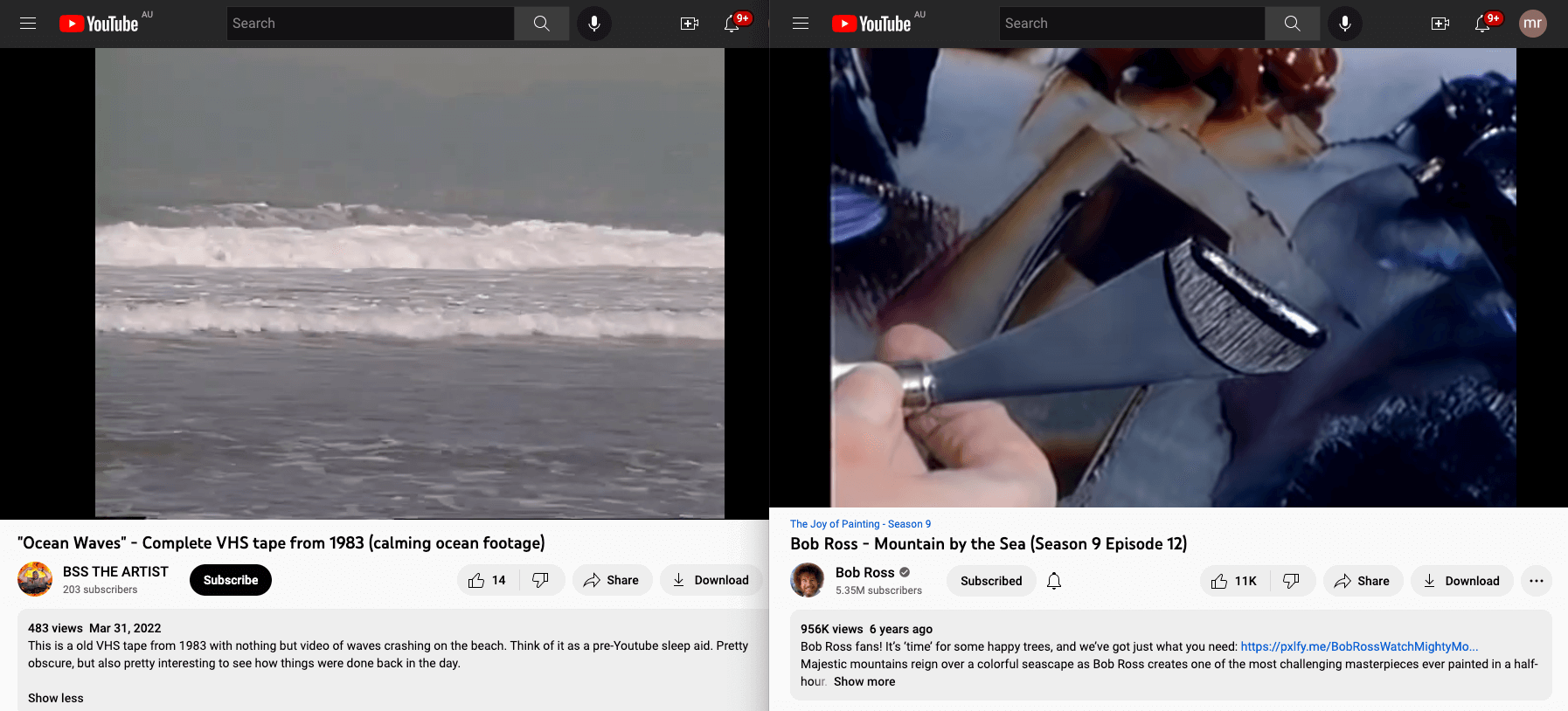 Ross softly shares oil painting tips, like making sounds to get the shapes of waves right. He impersonates waves crashing: schoo, tchwoong! His paint brushes make gentle scratchy sounds as they sweep across the canvas. I am haunted by a desire to be one of Ross’s canvases.
Ross softly shares oil painting tips, like making sounds to get the shapes of waves right. He impersonates waves crashing: schoo, tchwoong! His paint brushes make gentle scratchy sounds as they sweep across the canvas. I am haunted by a desire to be one of Ross’s canvases.
Before ASMR videos, there were also guided meditations, relaxation tapes, Lita’s Massage Clips, and Maureen Garth books. There were Avon ladies and ladies who love curtains [1]. There was my primary school ‘computer time’ teacher, a delicate woman in her 70s with a pyramid of grey hair, who always spoke in a low parched whisper. She conducted her classes with the lights switched off and the air conditioning turned up high. Her cold cavern was lined with Windows ’95 computers.
The blue light emanating from the bulging screens glowed like stained glass windows. I have vivid memories of this teacher instructing us to ‘double click the little mouse button,’ her cadence clattering pleasurably over her words with a strange reverence, as if we were preparing to complete a technopagan ritual together.
ASMR videos are their own kind of post-internet ritual. Like relaxation tapes, ASMR videos are named after the feeling they are meant to produce: Autonomous Sensory Meridian Response, a term coined by Jennifer Allen only in 2010 to describe a relaxing tingling sensation. The videos tend to show a person performing quiet sounds and slow movements for a camera. The specific sounds and movements vary, but many are accompanied by canorous words whispered into sensitive binaural microphones [2]. A diverse range of key terms categorise ASMR videos into searchable genres: soft spoken, whispered, keyboard sounds,
A diverse range of key terms categorise ASMR videos into searchable genres: soft spoken, whispered, keyboard sounds,
massage, tapping, gaming, mukbang, inaudible whispers, cranial nerve exam, haircut, layered sounds, trigger compilation, unintentional ASMR, role play, personal attention. Videos that are over an hour in length are common and many have been watched millions of times on YouTube, or an ASMR-aligned app, like Calm or Tingles [3]. ASMR content is watched to various ends: to produce the feeling of ASMR proper, as background noise, to decrease anxiety, or hasten sleep. ASMRtists – a common, clunky portmanteau for producers of ASMR content (that I use reluctantly) – often complete their activities slowly and inefficiently. In the small subgenre of lid sound videos, for instance, jars are opened and closed in the most ineffective ways possible: the lids are twisted off and on slowly, repeatedly, with extended periods of the ASMRtist jangling the lid over the lipped opening of the jar, intentionally missing the tracks of the opening to elongate the lid’s journey downward. The performer takes their time to find the gentle musicality of the container and the best articulations for producing relaxing tones.
It is also not unusual to find ASMRtists caressing and caring for their camera as if it were a human, especially in role plays or personal attention videos. In these subgenres, the ASMRtist performs one half of a social encounter and interacts with the camera as if it were the viewer. The care demonstrated by the ASMRtist is parasocial, but performed as if their touches are received. For instance, in the opening minutes of Gentle Whispering ASMR’s video ‘... Face Tapping ... and Happiness 💆♀️ ASMR 💆♀️ Whisper Ear-to-Ear,’ she busies herself with tapping the camera/my face with her fingertips which have been bedazzled with jewel stickers.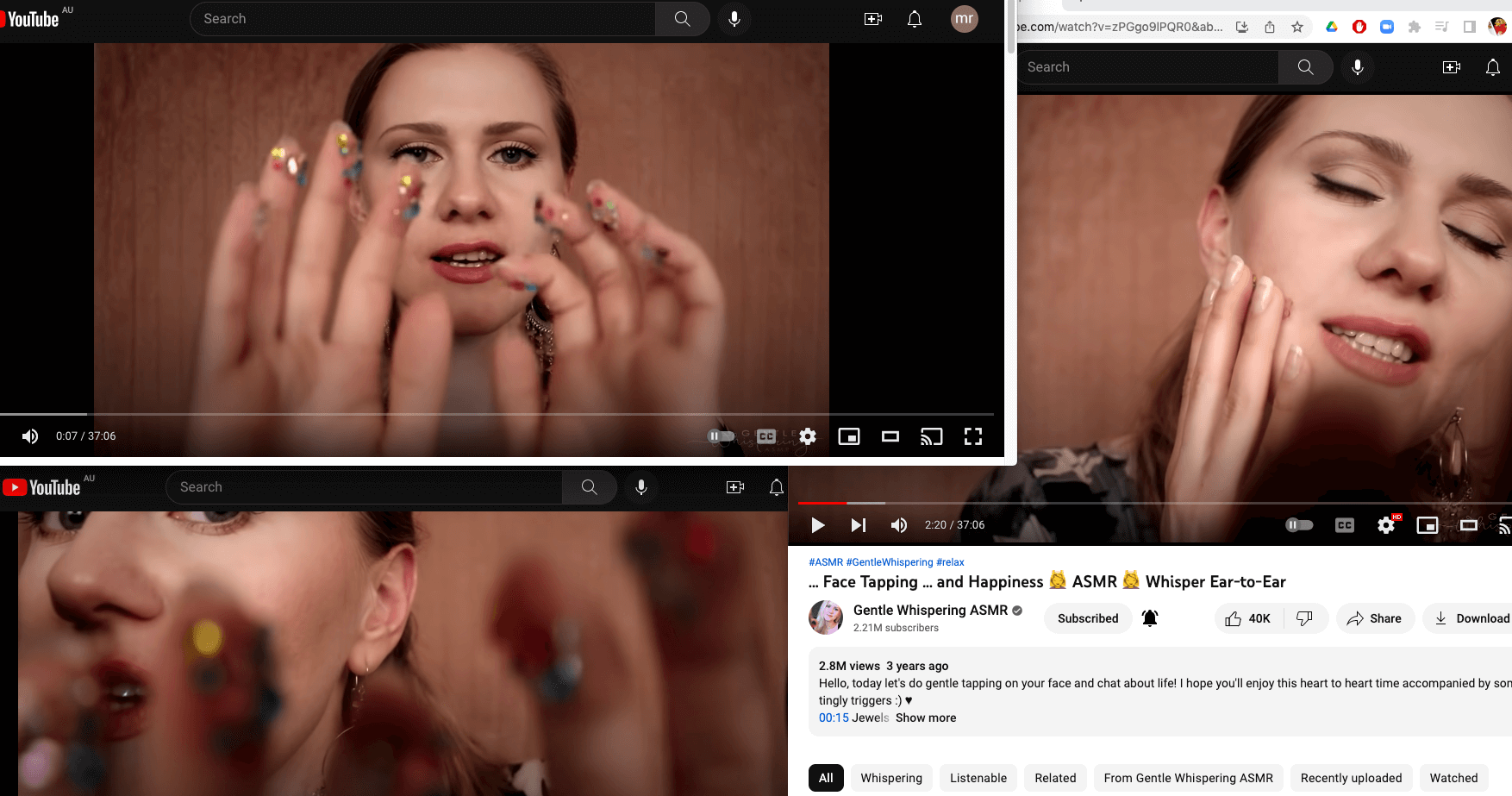 She slowly pads her fingers across the camera/my face, then her own. Every now and again, she directs her gaze towards me and speaks: ‘You know, I think that one of the most personal things [is] (…) when somebody touches your face.’ She also asks me questions, like, ‘How does this feel?’ All the while, she touches me/the camera, gently, slowly, and maintains a low whisper. Certain consonants catch on her tongue in little clacks that mirror the sounds coming from her bejewelled fingertips. Not so long ago, techno-utopianism had us believe that the internet brought the whole world to our fingertips. Now the internet is a place where someone's fingertips can explore my face.
She slowly pads her fingers across the camera/my face, then her own. Every now and again, she directs her gaze towards me and speaks: ‘You know, I think that one of the most personal things [is] (…) when somebody touches your face.’ She also asks me questions, like, ‘How does this feel?’ All the while, she touches me/the camera, gently, slowly, and maintains a low whisper. Certain consonants catch on her tongue in little clacks that mirror the sounds coming from her bejewelled fingertips. Not so long ago, techno-utopianism had us believe that the internet brought the whole world to our fingertips. Now the internet is a place where someone's fingertips can explore my face.
There are a number of endearing oddities that characterise the treatment of the camera/me in these videos. Firstly, cameras map imperfectly to human faces. This makes the experience of simulated touch imaginative and awkward. Secondly, the conventions of ASMR videos are still being formalised and therefore the encounter between ASMRtist and camera feels unvarnished. Thirdly, the viewer of ASMR content is treated as human and non-human at the same time. The viewer is at once a fleshy, supple, and affected person, but also reconfigured and ‘thingified’ [4]. Fourthly, the mediated experience of touch via an ASMR video is pleasurable not in spite of its blemishes, but because of them. Touch becomes full of intriguing contradictions: devised and improvised, human and non-human, everywhere and nowhere, embodied and disembodied, intimate and distant, felt and unfelt. It is something that is there, and not there, like a haunting. This haunting requires two conditions: a shared fantasy and a cyborg-like entanglement with technology.
In the realist tradition of photography theory, the camera is a mechanical device (the bearer of an objectif, an instantaneous reproduction machine) that records light. These assumptions inform a number of influential moments in photography theory that only work if we believe that the camera catches what is really there [5]. When I watch ASMR videos, the ghost of Walter Benjamin wafts through my door to remind me that when reproductive technologies (like photographs) first appeared, they made the world reachable in unprecedented ways, democratising access to otherwise exclusive experiences, like art and music (albeit with diminished aura) [6]. Benjamin’s arguments hold true for ASMR videos; there is a sense in which the ASMR content recorded on a camera makes the viewer feel as if they are in a shared space with the ASMRtist [7]. I feel as if Gentle Whispering ASMR is touching my face.
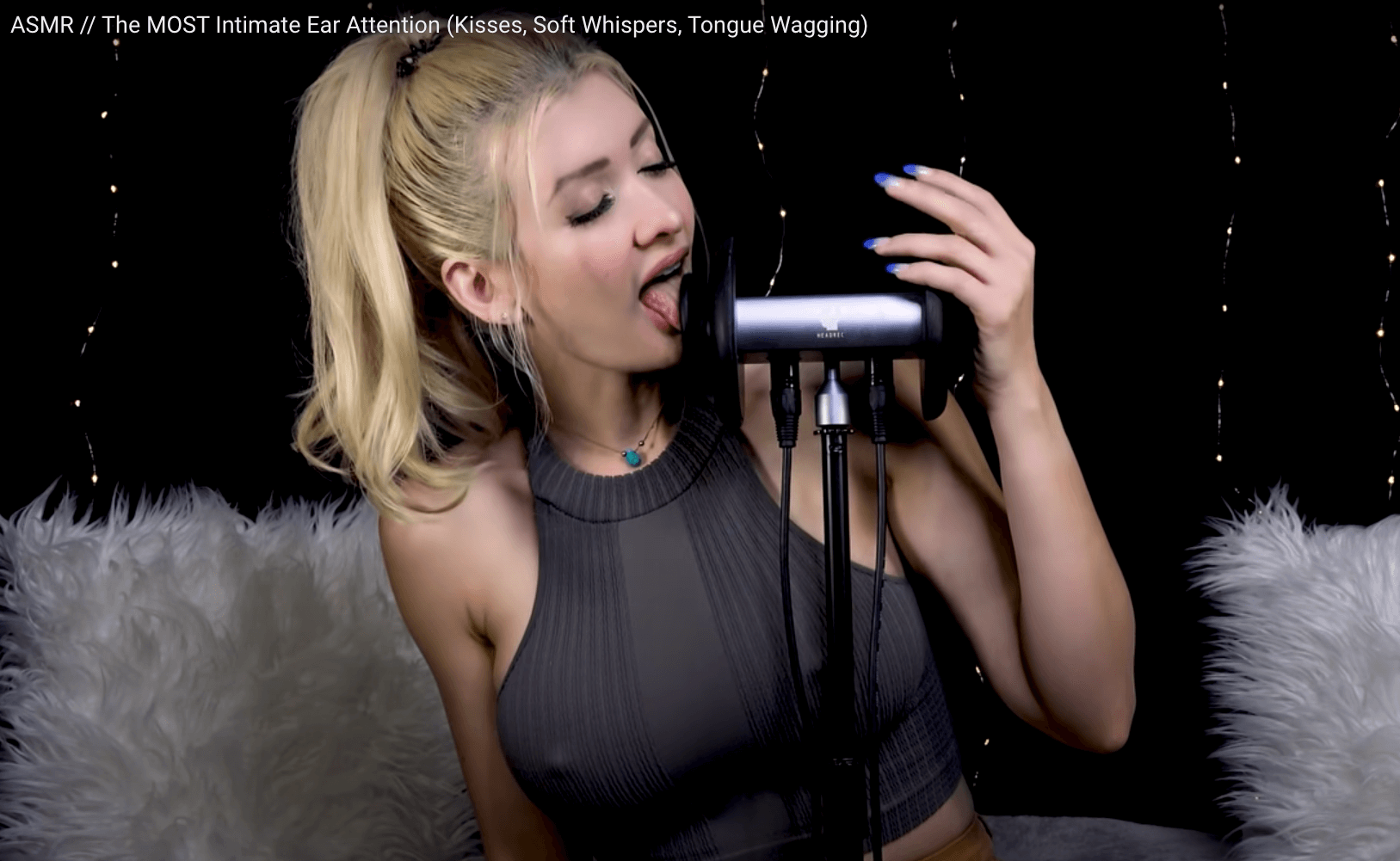 conventions into a cast of heteronormative fantasies directed toward the viewer, like ‘Flight Attendant Takes You To Paradise 🤤,’ ‘Cheerleader Boosts Your Confidence,’ and ‘Doctor Asks You VERY Personal Questions.’
conventions into a cast of heteronormative fantasies directed toward the viewer, like ‘Flight Attendant Takes You To Paradise 🤤,’ ‘Cheerleader Boosts Your Confidence,’ and ‘Doctor Asks You VERY Personal Questions.’ In ASMR videos, the camera often substitutes the eyes of the viewer as well as the sensory surface of the viewer’s body. The viewer not only identifies their gaze with that of the camera lens, but also their skin with the hard outer shell of the camera. This is encouraged by the ASMRtist who touches their camera as if it were the viewer. This could be regarded as a shared act of ‘playing pretend’: the ASMRtist pretends that the camera is the viewer, and the viewer joins in the fantasy by pretending to be the camera.
In ASMR videos, the camera often substitutes the eyes of the viewer as well as the sensory surface of the viewer’s body. The viewer not only identifies their gaze with that of the camera lens, but also their skin with the hard outer shell of the camera. This is encouraged by the ASMRtist who touches their camera as if it were the viewer. This could be regarded as a shared act of ‘playing pretend’: the ASMRtist pretends that the camera is the viewer, and the viewer joins in the fantasy by pretending to be the camera.A rare direct address of this fantasy takes place in ‘1300s A.D. ASMR~ Nun Takes Care of You In Bed {You Have the Plague}.’ In this video, the ASMRtist, Angelica, plays a perturbed nun. She reluctantly cares for the camera/me – a mediaeval townsperson dying of the Bubonic Plague – but only after receiving my life savings. The role play is thoroughly tongue-in-cheek, exaggerated to the point of absurdity, sometimes veering into hilarious cruelty. (These tendencies characterise many of Angelica’s videos and offer a welcome interruption to a genre that can be dominated by disquieting performances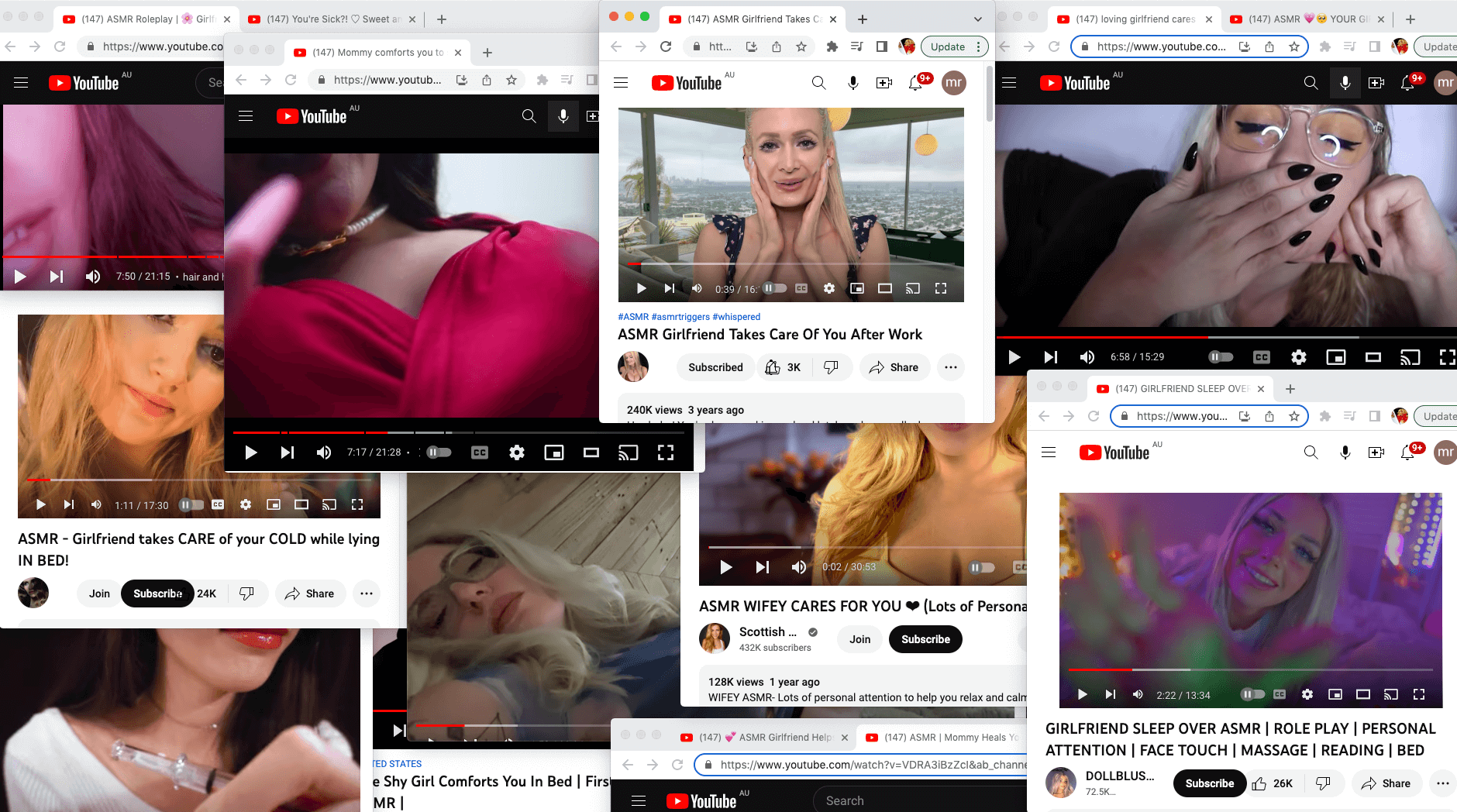 of a kind of heteronormative femininity that conflates girlfriends with busty ‘mommies’ who perform domestic labour, usually with impressively long nails [9].) Since I’m so sick, the nun refuses to touch me. Instead, she blesses me with ‘holy water’ stored in a plastic bottle
of a kind of heteronormative femininity that conflates girlfriends with busty ‘mommies’ who perform domestic labour, usually with impressively long nails [9].) Since I’m so sick, the nun refuses to touch me. Instead, she blesses me with ‘holy water’ stored in a plastic bottle that she ‘splashes’ near my face, but not on it. She explains:
that she ‘splashes’ near my face, but not on it. She explains:
I’m not actually splashing it on you because I don’t want to waste my holy water on someone who is basically going to die soon, but, you know, for, you know, your comforting sake – I’m not touching you! No, I’m not touching you! – but, for your comforting sake, I want you to think I’m splashing it on you, so that way you feel like something is going on, something to your benefit. Splash!
This self-reflexive backhanded blessing does not involve touch, but it provides an additional model for understanding how touch operates in ASMR videos. Like a haunting, a blessing occurs without tactile feedback – it requires faith. In spite of its haptic lacks, we believe that ‘something is going on’.
Enmeshed with the ASMR cyborg, I discover that my textures and physical limits are a series of contradictory experiences. My eyes can be touched and I won't flinch. My nostrils and mouth can be covered without smothering me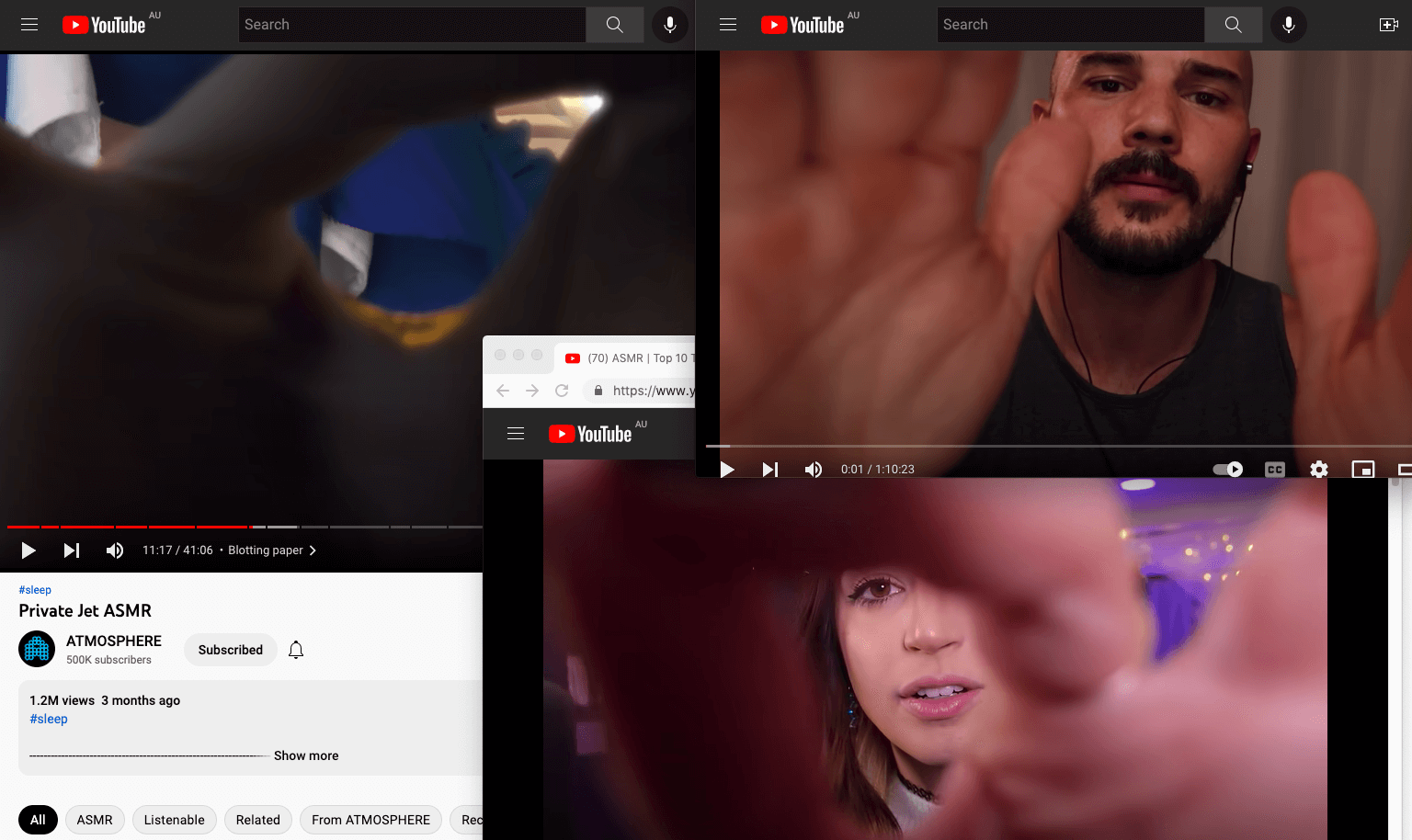 . I can be painted with a stranger’s spit
. I can be painted with a stranger’s spit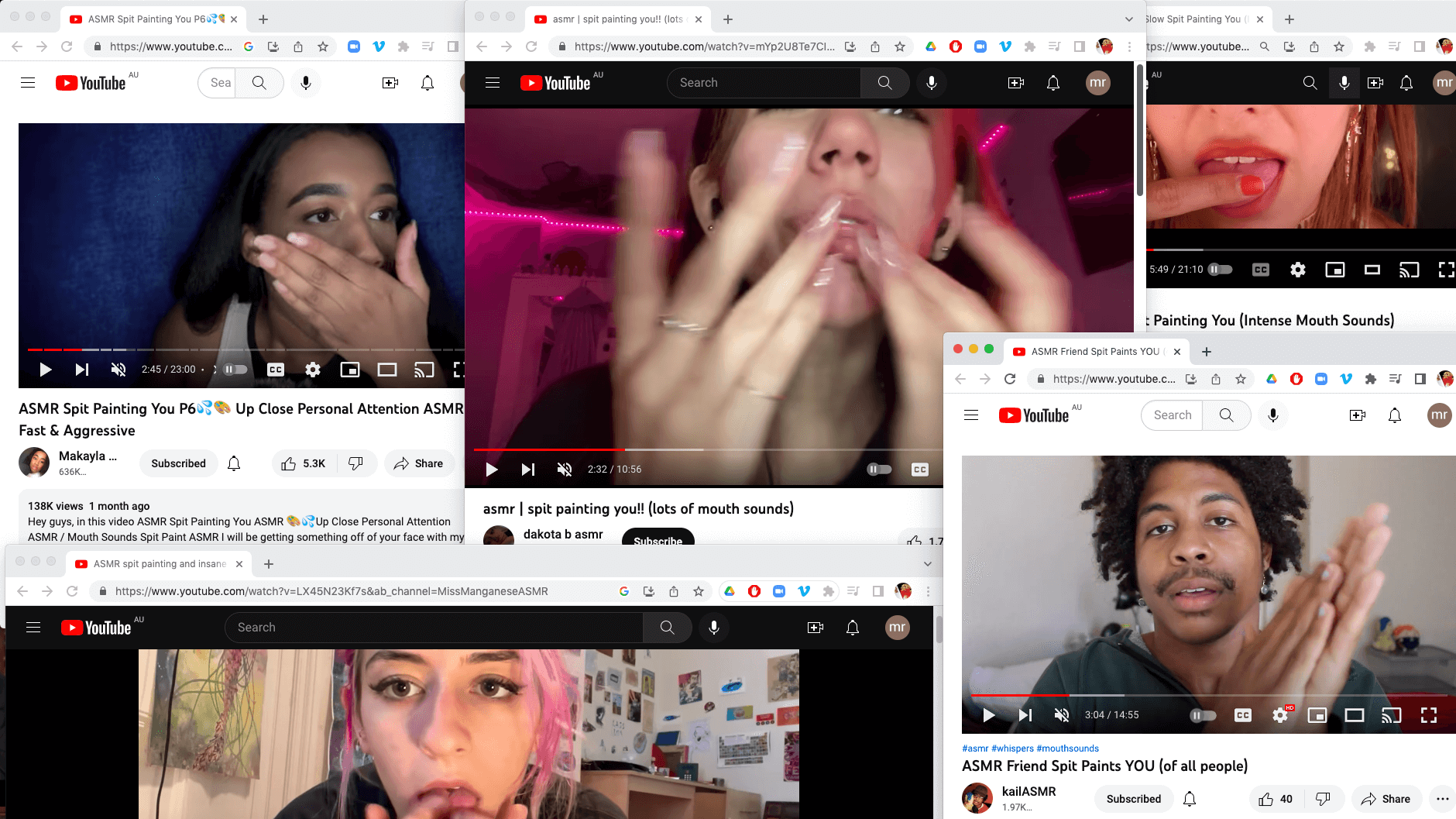 during a pandemic. I can be covered with endless amounts of make-up. My teeth can be softened and hardened
during a pandemic. I can be covered with endless amounts of make-up. My teeth can be softened and hardened again by a cyberpunk doctor. A mechanic can clean the engine I’ve suddenly acquired which seems to emanate from my stomach. I can experience these things as pleasures instead of weird infringements.
again by a cyberpunk doctor. A mechanic can clean the engine I’ve suddenly acquired which seems to emanate from my stomach. I can experience these things as pleasures instead of weird infringements.
In a behind-the-scenes video shot by Gentle Whispering ASMR, she reveals a camera that she has set up for a haircut role play. The camera is mounted on a mannequin that she has seated in an office chair. It is wearing a wig. Long brunette locks spill over either side of the camera’s cycloptic eye. It’s adorned with pink hairdressing clips and two large microphones pointing outward like Baby Spice’s pigtails. At first I’m startled, but then I realise – I’m looking at one end of the ASMR cyborg. This part of the assemblage can be doted on in my absence, besieged with untreated plague and sponsored content,
Long brunette locks spill over either side of the camera’s cycloptic eye. It’s adorned with pink hairdressing clips and two large microphones pointing outward like Baby Spice’s pigtails. At first I’m startled, but then I realise – I’m looking at one end of the ASMR cyborg. This part of the assemblage can be doted on in my absence, besieged with untreated plague and sponsored content, covered in spit and make-up. When it bares its teeth, they soften and harden on my behalf.
covered in spit and make-up. When it bares its teeth, they soften and harden on my behalf.
I find a video of FredsVoice ASMR doing his best Bob Ross impersonation, replete with painting tips, permed wig, and chambray shirt.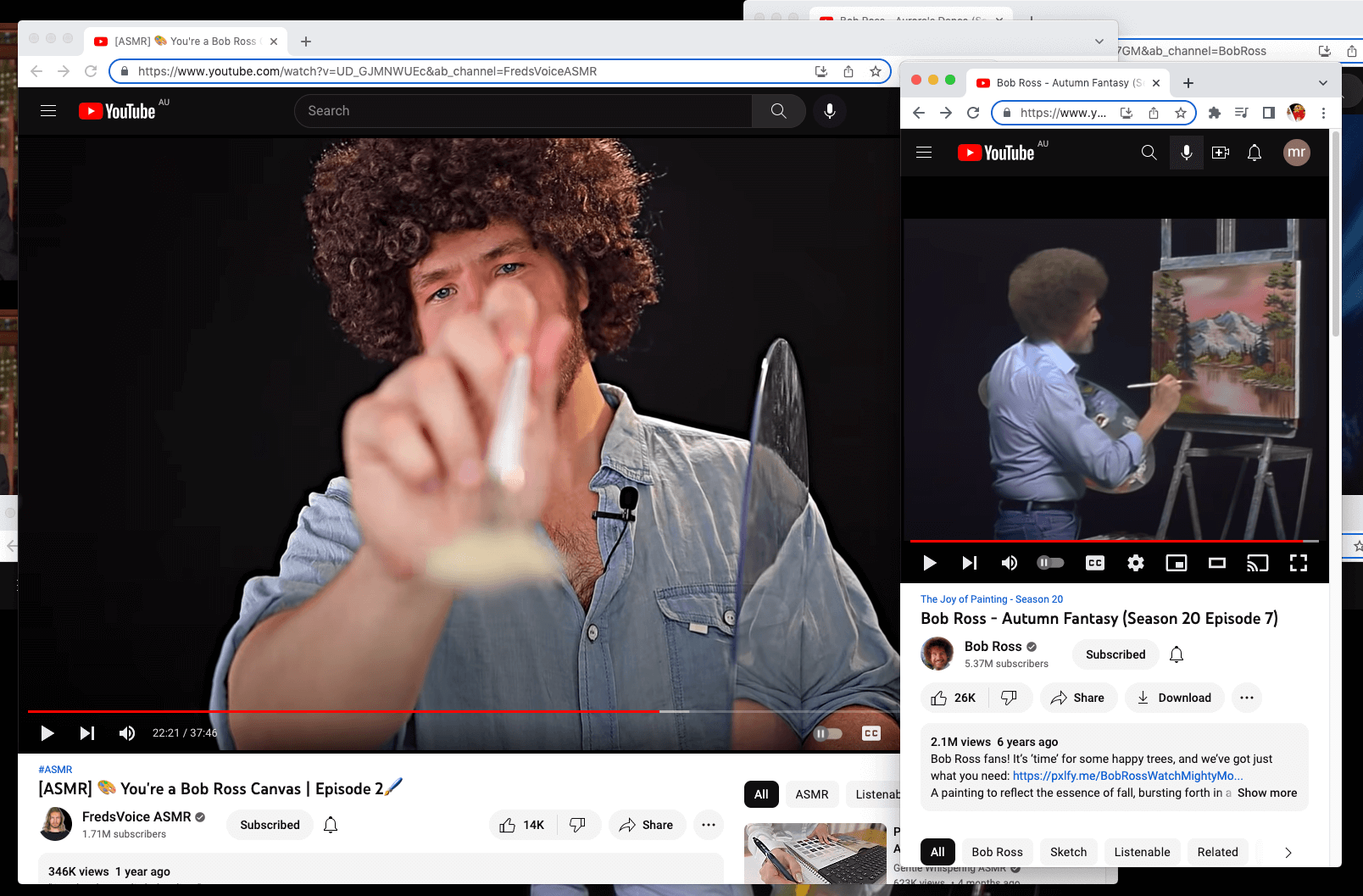 He applies a phthalo green sea to my face. I hear the ocean in his brushstrokes.
He applies a phthalo green sea to my face. I hear the ocean in his brushstrokes.
[1]
Sometimes I feel like footnotes are secrets that the author whispers to the reader.
[2] Before their formalisation, ASMR videos were often referred to as ‘whisper videos’ due to the prevalence of whispered commentary. Reflecting this tendency, many early ASMR channels bore usernames containing references to whispering: WhisperingLife, WhisperSister, AuroraWhispers, TheWhisperWinds, GentleWhispering etc.
[3]
ASMR content has also begun to appear on TikTok and Twitch.
[4]
My observations here are indebted to Emma Bennett’s essay, ‘Relief from a Certain Kind of Personhood in ASMR Role-Play Videos.’ See The Restless Compendium: Interdisciplinary Investigations of Rest and Its Opposites, edited by Felicity Callard, Kimberley Staines, and James Wilkes, Cham: Palgrave Macmillian, 2016, 129-136.
[5]Among them are André Bazin’s (1945) association of photographs with death masks and Roland Barthes’ (1980) notion of punctum (a precognitive affect which ‘pricks’ the viewer with the disturbing presence of an unbearable real) which sometimes asserts itself in photographs of fleeting moments. See Bazin, ‘The Ontology of the Photographic Image’ (1945), Film Quarterly 13, no.4 (1960): 4-9; Barthes, Camera Lucida: Reflections on Photography, New York: Farrar, Straus and Giroux, 1981.
[6]Benjamin writes, ‘technical reproduction can put the copy of the original into situations which would be out of reach for the original itself. Above all, it enables the original to meet the beholder halfway be it in the form of a photograph or a phonograph record. The cathedral leaves its locale to be received in the studio of a lover of art; the choral production, performed in an auditorium or in the open air, resounds in the drawing room.’ See Walter Benjamin, ‘The Work of Art in the Age of Mechanical Reproduction,’ in Illuminations, New York: Shocken Books, 1968, 220-221.
[7]
Postmodernist photography theorists (among many other critical thinkers) would argue that a static, stable real is a kind of fantasy.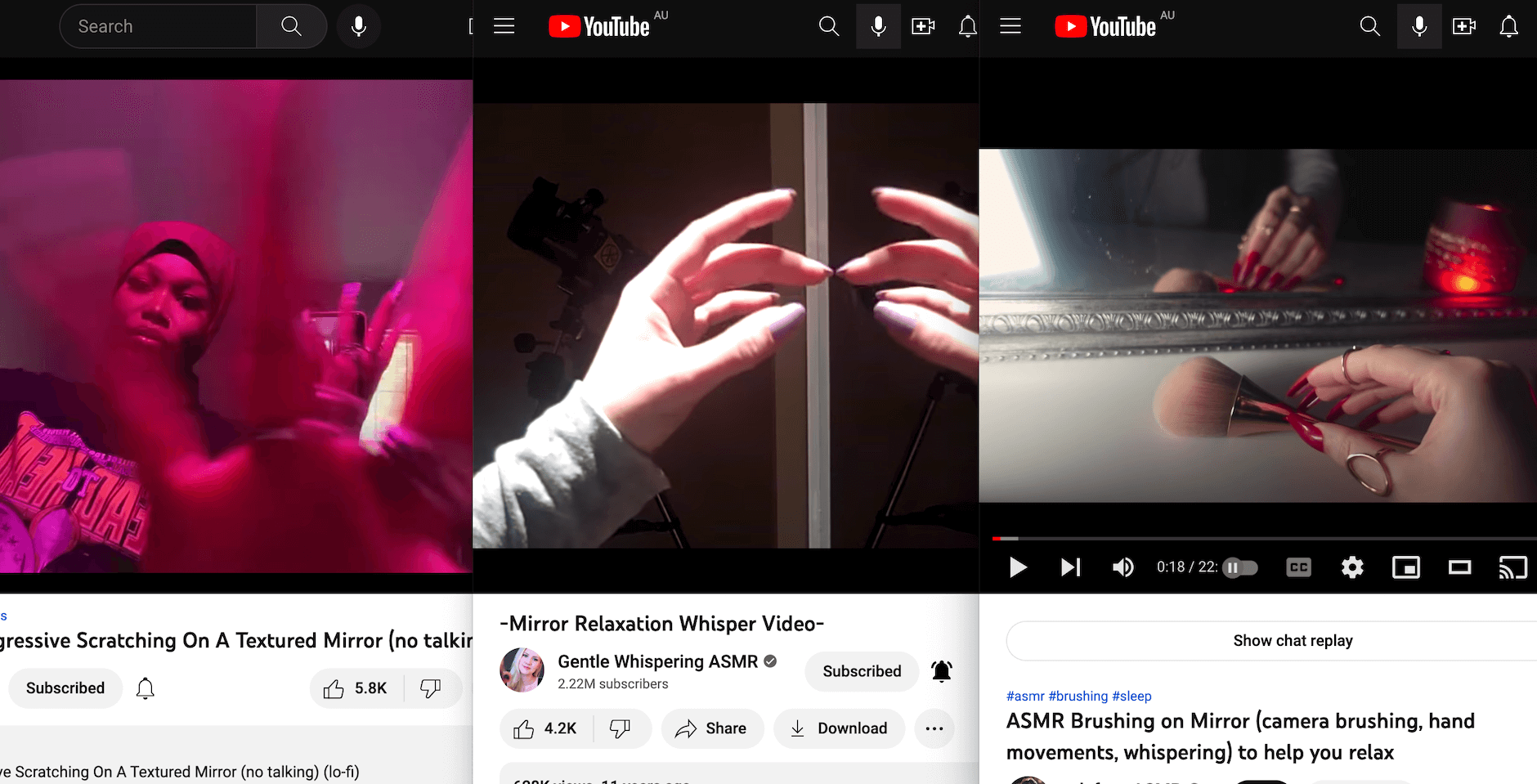
[8]
In Lacanian psychoanalytic theory, the mirror stage is a developmental phase in which the infant slowly becomes aware that they are actually a separate entity to their parent. For Lacan, this plays out as a sort of drama in which the infant begins to identify with their reflection in the mirror, among other things, images, and people. See Christian Metz, The Imaginary Signifier: Psychoanalysis and the Cinema, Bloomington and Indianapolis: Indiana University Press, 1982, and Jacques Lacan, Écrits: The First Complete Edition in English, New York and London: W. W. Norton & Company, 2006.
[9]
Many of these videos do not shy away from explicitly referencing this caricature and her expected duties in their titles (alongside SEO terms, emojis, and decorative punctuation flairs reminiscent of MSN messenger usernames). See: ASMR leedah, ‘ASMR | Mommy Heals Your Wounds After A Fight POV🩹’ https://youtu.be/QrRSE4VekYs; ASMR Maddy, ‘ASMR Girlfriend Takes Care Of You After Work’ https://youtu.be/1izv1Eqlmhs; Daisy Banaisy ASMR, ‘You're Sick?! ♡ Sweet and Caring Girlfriend Takes Care of You ASMR ♡’ https://youtu.be/kTTVWAwxwjA; edafoxx ASMR, ‘Mommy comforts you to sleep ASMR shh, head scratching, personal attention’ https://youtu.be/7gzYRw9CA8Y; Pelagea ASMR, ‘ASMR - Girlfriend takes CARE of your COLD while lying IN BED!’ https://youtu.be/-aUwtFVTIMg; Phoenix ASMR, ‘ASMR Roleplay | 🌸 Girlfriend Takes Care of You Date, Personal Attention 💖’ https://youtu.be/KnPUSgdEUJ0; Pigeons ASMR, ‘💕 ASMR Girlfriend Helps You Relax After Work 💕’ https://youtu.be/QrRSE4VekYs; RoseASMR, ‘loving girlfriend cares for you after a long day ❤️ ASMR’ https://youtu.be/kev2zkTjHu4; Scottish Murmurs ASMR, ‘ASMR WIFEY CARES FOR YOU ❤︎ (Lots of Personal Attention)’ https://youtu.be/DmP9Gfv_C0c; tatti asmr, ‘ASMR 💗🥺 YOUR GIRLFRIEND WILL HEAL YOU and TAKE CARE ✨ RP’ https://youtu.be/JCAdIaVyEAg.
[10] Haraway wrote about the cyborg in 1985 as both a material reality and as an ‘imaginative resource’ that moves away from the fantasy of a ‘natural’ whole human. Paul B. Preciado’s summary of this figure: ‘As Donna Haraway teaches us, the contemporary body is a techno-life, multi-connected net that incorporates technology. It is neither an organism, nor a machine; nature, nor culture: it is a techno-body.’ See Donna Haraway, ‘A Cyborg Manifesto’ (1985), in The Cybercultures Reader, eds. David Bell and Barbara M. Kennedy, London and New York: Routledge, 2000, 34-65, and Paul B. Preciado, ‘Pharmaco-pornographic Politics: Towards a New Gender Ecology,’ Parallax 14, no.1 (2008): 111.
[11]
For Haraway, the cyborg is always a historically specific and material entity, not just an isolated meeting of machine and human. There is not space here to adequately discuss this point, but the ASMR cyborg has a knotty relationship with capitalism. In addition to my body and the ASMRtist’s camera (and all the other tech and the labour that goes into producing them), the ASMR cyborg is also entangled with kitsch commodities sometimes inserted into the videos themselves in the form of ads and sponsored content performed by some ASMRtists. Many videos also appear to rehearse commercial exchanges, emotional labour, and care work. Since the videos are posted on YouTube, which is owned by Google, the ASMR cyborg is also entangled in surveillance capitalism. The ASMR cyborg is not a neutral assemblage of technologies; it is at once an avenue for mediated comfort and a conduit for capitalism. See Donna Haraway, ‘Cyborgs, Dogs and Companion Species,’ lecture presented at The European Graduate School, 2000 (available as a nine-part video recording here: https://youtu.be/-yxHIKmMI70), and Shoshana Zuboff The Age of Surveillance Capitalism, New York: PublicAffairs, 2019.
ASMR sounds and whispers performed by Dominic Logel and Melinda Reid with sound production completed by Natalie Reid on unceded Gadigal and Wangal lands of the Eora Nation.
Runway Journal acknowledges the custodians of the nations our digital platform reaches. We extend this acknowledgement to all First Nations artists, writers and audiences.
Runway Journal is assisted by the Australian Government through the Australia Council, its arts funding and advisory body.

Runway Journal receives project support from the NSW Government through Create NSW.

Runway Journal acknowledges the custodians of the nations our digital platform reaches. We extend this acknowledgement to all First Nations artists, writers and audiences.
Runway Journal is assisted by the Australian Government through the Australia Council, its arts funding and advisory body.

Runway Journal receives project support from the NSW Government through Create NSW.














